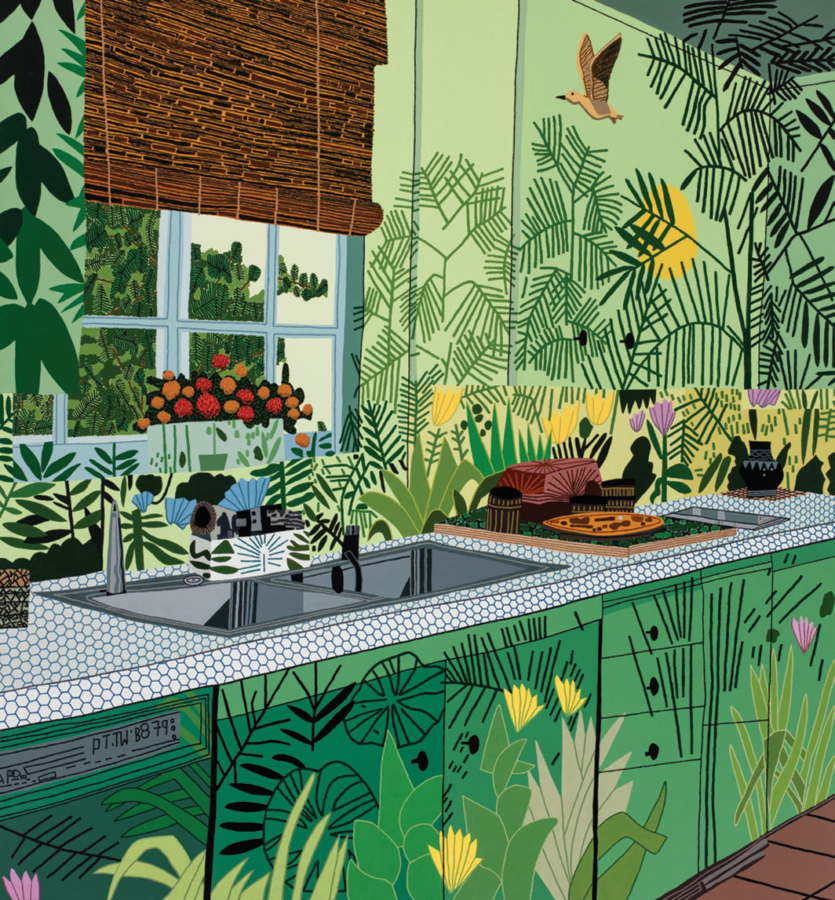September 1, 2019
Download as PDF
View on Artforum

Jonas Wood, Jungle Kitchen, 2017, oil and acrylic on canvas, 100 × 93″.
Jonas Wood’s first major solo museum exhibition happened to coincide with a showing of seventy works by the Impressionist Berthe Morisot. On the surface, the two artists’ paintings are very different, but in fact their congruence is strong. Like Morisot, Wood depicts sentimental scenes of domestic life with family, friends, pets, and houseplants. Yet Wood’s banal, recognizable subjects are often made to feel extraordinary through a colorful profusion of visual information and ornamentation, and a palette associated with a certain Southern California light, also found in the upbeat paintings of David Hockney. The resulting images are pleasing, even comforting, in their thematic plainness. His paint-by-numbers approach can at times feel predictable, even stodgy. The portraits are especially clunky. In most cases, the renderings of faces and bodies are unduly stiff and lack any countervailing élan. It is when this method is applied to a landscape or to interior spaces that the paintings are most impactful.
In the standout Japanese Garden, 2017, for example, on view here, Wood depicts a manicured landscape as a series of overlapping patterns. The canvas appears to have been sectioned off to contain smaller markings accumulating into a view of trees, rocks, and water. The collage-like puzzle of contiguous shapes and multihued surfaces builds to an optical crescendo that intensifies the rendering and sidesteps the sameness of Wood’s technique. The picture is simultaneously schematic and observational.
Wood’s predilection for patterns was also evident in Jungle Kitchen, 2017, where he has applied a curious treatment to the material objects within the scene. The mass of repetition in the bamboo blind is nearly discordant against the flat-green walls and cabinetry. The most interesting aspects of this work are the swaths of what could be floral wallpaper floating across the dishwasher, the drawers, and the backsplash. A bird improbably appears to either emerge from the wallpaper or fly inside the room. These optical slippages invite and reward careful scrutiny.
Despite the clumsy quality of most of Wood’s portraits, a few transcend robotic simplification. An outstanding exception here was Akio Takamori, 2014, which exhibits Wood’s typical technique but showcases a sensitivity not present in many of the other figurative works. Takamori’s hand and neck are loosely brushed compared to his face, which is painted with slow and delicate layers. His visage is mirrored in a ceramic vessel he seems to be making, while other faces are represented on a jug and vase in the upper-right corner of the painting. This hall of mirrors, offset by a childlike rendering of art materials, creates a beguiling push and pull between the different manners of description.
Despite awkward limitations and some mawkish meanderings, Wood’s oeuvre is graced by his enthusiasm for elaborating on the abstract within the quotidian. Wood, like Morisot, is a pictorial bricklayer intent on making the commonplace more than common.



